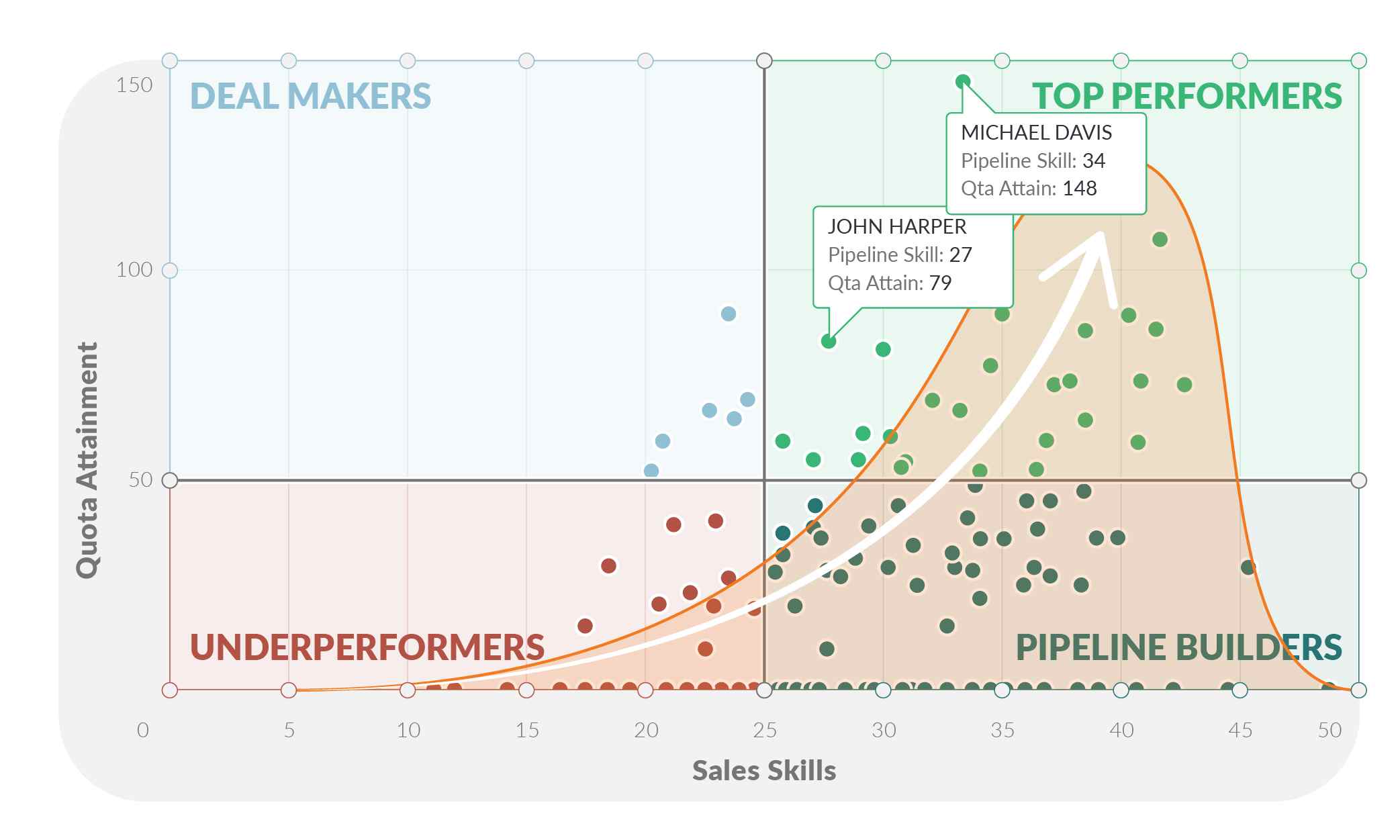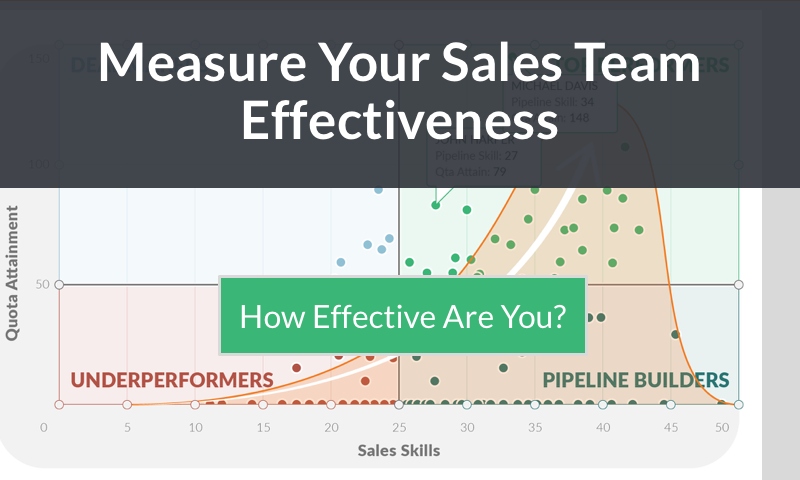Sales Effectiveness Metrics For Evaluating Your Team [INFOGRAPHIC]
Xant Team
![Sales Effectiveness Metrics For Evaluating Your Team [INFOGRAPHIC]](https://resources.insidesales.com/wp-content/uploads/2019/08/Feature-Image-Xant-Sales-Effectiveness-Metrics-1200x672.jpg)
Having sales metrics in place is vital for tracking a team’s performance and motivating employees. Find out how a team’s performance can be measured with these metrics for sales effectiveness below.
RELATED: 14 Key Sales Metrics [Infographic]
In this article:
- The Use Of Sales Force Effectiveness Metrics
- Why Sales Is Broken and Why Technology Won’t Fix It…
- What Metrics Should I Use For Measuring Sales Performance?
- How To Conduct a Sales Effectiveness Assessment
- Who Are Your Top-Performing Sales Reps?
Measure Your Team’s Sales Effectiveness with These Metrics
Click here to jump to the infographic.Various trends in the sales industry find that there’s a growing need to measure sales effectiveness in sales teams. However, these trends aren’t the only reasons why you should consider measuring your team’s sales effectiveness.
The Use Of Sales Force Effectiveness Metrics
There’s a sleuth of metrics that sales managers use to evaluate sales performance, some more important than others. Now more than ever, sales managers should be working on improving their sales evaluation process.
Quota attainment has been on a downward trend for the last five years, and it’s now at only 53% (Miller Heiman statistics).
This percentage has steadily decreased from 63% over the last five years. Plus, it’s showing not only a skill gap for sales reps but also a lack of sales coaching and training that is directed towards improving results.
Not only is this hurting the bottom line of companies, but it’s also leading to high turnover in the industry. This also puts extreme pressure on the sales force.
The average tenure for a sales rep is only 24 months, and 26% of sales reps quit because of missing quota, shows research from DePaul University in Chicago.
So, why aren’t more salespeople hitting quota?
Why Sales Is Broken and Why Technology Won’t Fix It…
There are a few indicators that show the changes that are happening in the sales industry. The indicators show that the answer seems to lie in a combination of factors.
Systems, people, and processes need to all work seamlessly for salespeople to reach success, and this is not happening.
Sales Reps Are Not Spending Their Time Selling

This might come as a shock, but sales reps spend less than half of their day actually selling. Sales reps spend only 36% of their day selling, show the “Time Management for Sales Reps” study from XANT.
The struggle is real, as the study shows, sales reps spend around 12% of their day on internal policies and approval. They spend another 15.7% on meetings and customer interaction.
They also spend another 12% on researching target accounts and contacts. This means a majority of their day (about 64%) is taken up by activities that simply don’t generate revenue.
Time Spent in Customer Relationship Management (CRM) Is Going Down
While almost all companies who employ sales professionals today use CRM, adoption among sales reps is not ideal. Sales reps today spend only 18.0% of their time in CRM, the foundational system for sales teams.
Because of the inefficiency of CRM, sales reps report that they spend 9.7% of their time (over half the amount of time spent in CRM) in spreadsheets. Basically, they are trying to more effectively manage CRM related tasks.
Sales acceleration technologies come in to fill the gap, being the sales systems rated most effective by sales reps. These systems offer insights on customer behavior, which are not always readily available in the CRM.
Customer Relationship Management Definition: Also known as CRM, this is a strategy that sales professionals used to manage an organization’s interactions and relationships with customers and prospects. Salespeople often refer to the CRM system, a tool that helps them with sales and contact management, productivity, etc.
Sales Reps Are Not Having Meaningful Conversations Anymore
One concerning trend is that sales representatives are no longer as effective at having meaningful conversations with their prospects.
Sales reps now prefer contacting leads via email rather than having phone conversations. This makes them less effective at establishing a relationship.
Over half (61%) of first contacts between sales reps and leads now happen via email. Email is now the most common outreach practice (32 respondents say they use this sales communication method).
Other data shows that when sales reps focus on calling rather than emailing, they have 15% more meaningful conversations.
“Phone calls result in much stronger sales conversations than email,” says Martin Moran, International Managing Director for XANT.
“Reps voice a preference for email, but the email focus has only hurt their results. I expect the pendulum to swing back to the phone in the U.S. as companies begin to recognize the decrease in results,” added Moran.
Kenneth Krogue, President and Co-Founder of XANT, describes 12 metrics you should measure for sales performance. You can find it in the whitepaper named “12 High-Velocity Metrics That Actually Increase Results.”
And the first thing on the list is response time: how fast does your team respond to leads (immediacy).
RELATED: 12 Tops For Evaluating Sales Reps Performance
Not Using Sales Acceleration Technology
In recent research from DePaul University, we see that over half of companies are using sales acceleration technology, with positive results.
“Firms in the study reporting the use of at least one type of sales acceleration technology compared to those not using any, on average, had higher performance respective of sales growth, meeting/exceeding quota achievement, and turnover,” show study authors.
While implementing sales acceleration technologies can undoubtedly help performance, it is not enough alone for improving sales performance.
“Sales representatives – especially millennials – won’t adopt a technology if they don’t understand how it helps them and why they should use it. What’s in it for me – this has to be very clear to them,” said Gabe Larsen, VP of XANT Labs.
Inbound Leads Are Not Getting Enough Attention

We never saw this one coming, but there’s actually a debate out there on whether you should respond immediately to inbound leads or not.
Sales reps report having around 12 to 15 touches (attempt to contact) per lead. Meanwhile, the reality is they have only four touches per lead.
So there is a vast difference between what reps think they are doing, compared to what they are actually doing.
Most companies don’t have a properly tested sales cadence for the lead response, which results in a lost opportunity. Moreover, in the study, 40% of leads never got a response at all.
What Metrics Should I Use For Measuring Sales Performance?
Sales teams will use different metrics for evaluating sales performance based on their industry, company size, market characteristics, or product.
However, a few metrics can accurately describe how sales reps fare—even compared to past performance. Incorporating these key performance indicators can help your sales team bring in better results.
Before attempting to find the sales performance metrics that assess the sales effectiveness of your team, you should first define what sales effectiveness means for your business. It can mean all sorts of things for all kinds of people.
In this article, sales effectiveness will be defined as the average output that each team member can provide. Sales effectiveness metrics should then be able to reflect better whether or not your sales team is capable, given these stipulations.
With that said, here are three of the best sales metrics that you can use to measure the sales effectiveness of your team.
1. Sales Quota
According to the Harvard Business Review study “12 Sales Metrics That Matter Most”, quota metrics are one of the most relevant sales metrics to measure. It is among the top key performance indicators that sales managers must track to measure their teams’ performance.
Average quota attainment, percent of the organization reaching quota, quota attainment average, and average annual quotas for field and inside sales reps are in the top five metrics in this study.
The HBR study also lists metrics relating to the sales cycle, vertical sales adoption, SMB specialization, and different parameters that are role-specific (inside sales versus field sales).
2. Revenue

Having different metrics by sales specialization is a great strategy to increase the accuracy of your results.
Research shows that some companies are using revenue as a metric for judging sales development reps performance.
Commonly, sales development reps build pipeline. The number of appointments set is usually how sales managers measure their performance.
“In this study, we had some companies report that they are using the revenue to measure results of SDRs. That was the number one factor that was utilized in the variable portion of sales development reps, and I am surprised about that,” said Gabe Larsen, VP of XANT Labs.
You can listen to more on this as heard on the Playmakers Podcast.
“Variable compensation should connect to metrics that you feel you can own, that you can actively influence. Sales development representatives have an influence on revenue, but it’s an indirect one and not as much as the account executives,” Gabe Larsen added.
3. Conversion Rate (Lead Conversion)
As you go along the sales funnel, you should have key performance indicators set for each part of the sales pipeline. After all, closing a sale and converting a lead are two different things that require two different sales strategies.
With that said, there are times when you want to measure how well your sales team can convert potential customers into leads. In these cases, you can use the conversion rate as a sales metric.
Sales conversion rate is best measured by sales managers. You measure it by dividing the number of converted leads to the number of potential leads.
Once you’ve divided them, multiply it by a hundred to find the approximate percentage rate of conversions.
When you know the conversion rate of your sales team, you can have an easier time assessing other aspects of lead conversion. For example, with conversion rate knowledge, you’ll have a better understanding of customer acquisition costs and how to lower them without lowering conversion rates.
Once you understand your metrics, you can assess and train the sales team accordingly.
How To Conduct a Sales Effectiveness Assessment
To administer a sales effectiveness assessment, sales leaders need to pick metrics relevant to their organization, product, and sales process.
They need to find out what the sales methods and processes they are using to win their deals, and then teach these methods to lower-performing reps.
Sales managers can conduct sales effectiveness assessments on either a weekly or a monthly basis. The time will depend on the sales metrics they will be using as some operate better at a more macro or micro perspective.
The results must be openly and actively discussed with the sales team so that they are aware of their performance, and they can receive relevant feedback. Plus, these assessments give them the right push and shows them what their next steps should be to improve their performance.
Sales Effectiveness Training
XANT experiments have shown that the leadership activities of coaching and mentoring, and even sales team training courses, will positively impact the growth and retention of top performers.
By moving just 15% of lower-performing reps up into higher performing quadrants, the revenue impact can be significant for organizations.
Ron Hollis, Sales Effectiveness Consultant at XANT, advises organizations to use a scientific method in trying to identify their top salespeople. Additionally, the same should be applied when making sure their process is known and repeated throughout the company.
Rather than removing low performing sales reps, it’s less costly and more efficient to coach them and help them improve.
“I think sometimes identifying the problem is often the problem. If you look at health care, people don’t just go, ‘Hey, my hip hurts. I’m going to get a hip replacement.’ They actually go in, and they talk to the physician.
They will pick one that has done surgeries before. He probably has a pretty good track record, and he knows the best method to do so. He has a fellowship team, which means they really studied this,” said Ron.
Who Are Your Top-Performing Sales Reps?
According to the Sales Effectiveness Quadrant from XANT, two primary sales skills matter for sales performance. These are pipeline generation and closing skills.
Pipeline generation is when a sales rep tries to bloom interest in potential customers of the business’s products and services. On the other hand, closing skills are a set of skills that’ll urge customers to take the final transaction with your business, ending or closing the sales process with them.
According to how well they do, sales reps can be:
- Top Performers – sales professionals with lead generating skills as well as closing skills
- Deal Makers – sales professionals who excel at closing deals, but are lacking in lead generation abilities
- Pipeline Builders – sales reps who specialize in pipeline generation, however, they lack the ability to close
- Underperformers – sales reps who are lacking skills in both pipeline generation and closing sales deals
By figuring out who your top-performing sales reps are based on specific skills and aspects of the sales pipeline, you can better delegate the right tasks and customers to them. Plus, you can base it on their proven expertise and where they’re most comfortable.
It’s important to note, however, that this is not a traditional pyramid of sales performance. While some sales reps might have excellent pipeline building skills, they may not exceed at closing deals.
This doesn’t make them less valuable to an organization.
Useful Key Performance Indicators for Sales Effectiveness
Here are a few of the key performance indicators you can use to gauge the health of your sales organization:
| Pipeline Metrics | Quota Attainment Metrics |
| Pipeline Coverage – Do I have enough pipeline for me to achieve and exceed the yearly quota? | Win Ratio – the percentage of opportunities won |
| Sales Activities – On average, how many activities are tied to an opportunity? | Opportunity Health – the average risk of open opportunities based on push, activity, and velocity risk, engagement depth, and sales methodology alignment |
| Deals Opened and Closed in the Same Quarter – How many closed-won opportunities were opened and closed in the same quarter? | Deal Size – average opportunity amount of closed-won deals |
| Pipeline Replacement – Are there enough newly created opportunities to replace closed opportunities by quarter? | Sales Cycle – average length of time to close win an opportunity |
| Forecast Accuracy – How close or far is the day 10 forecast per quarter from actual closed-won at quarter-end? Is the rep closing deals forecasted versus revenue forecasted? |
Looking at the skills for the best performing sales reps and figuring out the process they are using to close deals and attain quota is crucial information. These will help you disseminate this information throughout the company and move the lower performing sales reps up in the ranks.
Why Measure Sales Effectiveness to Evaluate Your Team’s Performance?
Measuring sales effectiveness is a good way to evaluate your team’s performance and let them know how well they’re doing at the job assigned to them.
By measuring sales effectiveness of your team, you can also use the information to optimize and improve the sales effectiveness of your organization. Thus, the data you get shouldn’t just be used to scold underperforming members of the team.
Instead, overall sales effectiveness should help you understand what needs improving and fixing in the way things are done.
Don’t forget to download, save, or share this handy infographic for reference:
![Sales Effectiveness Metrics For Evaluating Your Team [INFOGRAPHIC]](https://resources.insidesales.com/wp-content/uploads/2019/08/20191107-Xant-Sales-Effectiveness-Metrics-304x600.jpg)
Remember when you’re choosing your sales performance metrics, it’s best to curate your KPIs. Do not only base it on the conversion rate or other more common vital sales metrics.
Some of the performance metrics are better than others when it comes to having an accurate overview of a sales team’s sales productivity. On that note, having a robust understanding of the sales pipeline and process within your organization is key to finding the best sales metrics for your sales team.
How do you measure your team’s sales effectiveness? Share what metrics you currently use to increase team productivity in the comments section below!
Up Next:
- Mapping The Sales Process: 6 Steps For Success
- Lisa Clark Shares The 3 Most Overlooked Sales Management Metrics
- A Winning Sales Culture Starts With The Right Sales Metrics

Editor’s Note: This post was originally published on Dec. 20, 2017, and has been updated for quality and relevancy.





